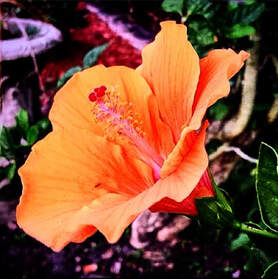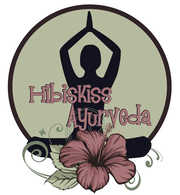|
NAMES
Scientific Name: Hibiscus moscheutos ssp. moscheutos Common Names: hibiscus, ambary plant, burao, rosa sinensis, red sorrel, karkadi, kenaf, African mallow, Indian sorrel, Jamaica sorrel, Jamaica tea flower, roselle, Sudanese tea, red tea (1) Sanskrit Name: Japā (2) Family: Malvaceae (1) Order: Malvales Kingdom: Plantae Rank: Genus Higher Classification: Hibisceae CONSTITUENTS The tart taste of hibiscus is due to is content of 15 to 30% plant acids, including citric, malic, and tartaric acids. The wine-red color of the tea is the to anthocyans, including delphinidins and cyanidins. In tea, the herb yields mucilage and pectins. (3) HABITAT Hibiscus sabdariffa is a member of the mallow family (Malvaceae) and is native to parts of North Africa and Southeast Asia. PARTS USED The flower, fresh, dried, cut, and powdered. (2) The calyx (the structure around the petals) are the primary plant part used, specifically in teas for lowering blood pressure and for its cooling effect. AYURVEDIC HERBAL ENERGETICS Dosha effect: PK- V0 (+ in excess) Rasa: madhura (sweet) and kashayam (astringent) (2) Virya: shita (2) Vipaka: madhura (sweet) (2) Gunas: sattvic, light, dry Hibiscus flowers taste madhura (sweet) and kashayam (astringent). (2) They are cold in terms of potency and can reduce aggravated Pitta and balance Kapha. ... Ayurveda refers to this condition as Raktapradar. DHATU AND SROTAS Rasa, Rakta, Mamsa, Majja, Shukra/Artava (3) Circulatory, artavavahasrotas, majjavahasrotas (3) KARMAS OF HIBISCUS Rakta Shodhan (alterative), hemostatic, shitala (refrigerant), emmenagogue, demulcent, shulagna (antispasmodic), diuretic (4) THERAPEUTIC USES Cystitis, fever, inflammatory skin disorders, dysmenorrhea, menorrhagia, cough, fever, venereal diseases, circulatory disorders, constipation, hair loss, infections, heart burn, toxins in blood (4) Hibiscus is a member of the Malvaceae family, or the mallow family of flowering plants. There are more than 200 species, all of which are known for their colorful, showy blooms. There are many folk remedies attributed to hibiscus flowers, including help with stomach or digestive problems, and to help soothe the nerves. Recently it has been added to many ready-made teas due to its high levels of anti-oxidants. The Journal of Human Hypertension published an article that showed that drinking hibiscus tea can reduce the blood pressure in people with type 2 diabetes. (5) CONTRAINDICATIONS Severe chills, high Vata. Pregnancy. May be a contraceptive. (4) Pregnancy was terminated in 92% of the animals and peripheral level of progesterone declined when benzene extract of Hibiscus rosa-sinensis flowers was provided orally at 1 gm/kg/d from day 5-8 of gestation (6) STUDIES In a randomized clinical trial with 100 patients with mild hypertension and diabetes, drinking an infusion of sour tea (Hibiscus sabdariffa) three times daily for four weeks was shown to significantly decrease both systolic and diastolic blood pressure. (6) In a randomized trial, patients with metabolic syndrome treated with a Hibiscus sabdariffa extract powder had significantly reduced glucose and total cholesterol levels, increased HDL-c levels, and an improved TAG/HDL-c ratio (t-test p<0.05). A triglyceride-lowering effect was also observed. (6) A one-year ethnobotanical study conducted by interviewing 48 people from Tamilnadu, India on their knowledge and uses of medicinal plants reported of the 139-plant species identified, Hibiscus rosa sinensis was ranked eighth in use value. (6) CONCLUSION African folk medicine uses hibiscus as a diuretic, to relieve pressure in the gallbladder, and to relax the uterus. The mucilage in the herb make it a mild laxative, but they are also helpful when the herb is used as a wash to treat weeping eczema. Regular consumption of hibiscus teas often lowers blood pressure, typically 8 to 12 mm/Hg. Hibiscus is also the source of the hydroxycitric acid (HCA, or hydroxycut) used in many diet formulas. This compound has been long used to fight obesity. Scientific studies with lab animals find that it stops the conversion of carbs in food to body fat. It fights appetite and encourages weight loss not by increasing energy expenditure but by encouraging the "wasting" of carbohydrates. HCA does not enhance weight loss during low-carb or Atkins-style diets, but it does help weight loss when used with a program of general calorie restriction reducing consumption of carbs, protein, and fats equally. Hibiscus powder will have more of a laxative effect than other forms of the herb. It delivers more HCA. It is also more likely to help lower LDL cholesterol, although definitive research of the use of this herb for controlling high cholesterol has not been completed. Hibiscus is Good for Controlling Pitta Diseases. (3) REFERENCES 1. Cms.herbalgram.org. 2020. American Botanical Council: Herb Med Pro. [online] Available at: <http://cms.herbalgram.org/herbmedpro/index.html#param.wapp?sw_page=@@subcategory%3FherbID%3D272> [Accessed 3 June 2020]. 2. Lad., V. and Frawley., D., 2001. The Yoga Of Herbs. Lanham: Lotus Press, p.124, 204. 3. O’Dunn, D., 2011. Florida Academy of Ayurveda, Herb Manual, Page 73 4. Alandi Ashram Herb Spreadsheet 5. Cms.herbalgram.org. 2020. American Botanical Council: Herb Med Pro. [online] Available at: <http://cms.herbalgram.org/herbmedpro/index.html#param.wapp?sw_page=@@subcategory%3FherbID%3D272> [Accessed 3 June 2020]. 6. Cross J. MEDLINE, PubMed, PubMed Central, and the NLM. Editors' Bulletin. 2006;2(1):1-5. doi:10.1080/17521740701702115
1 Comment
Leave a Reply. |
AuthorLearn more about Prema Shakti at www.premashakti.guru Archives
April 2022
Categories |

 RSS Feed
RSS Feed
